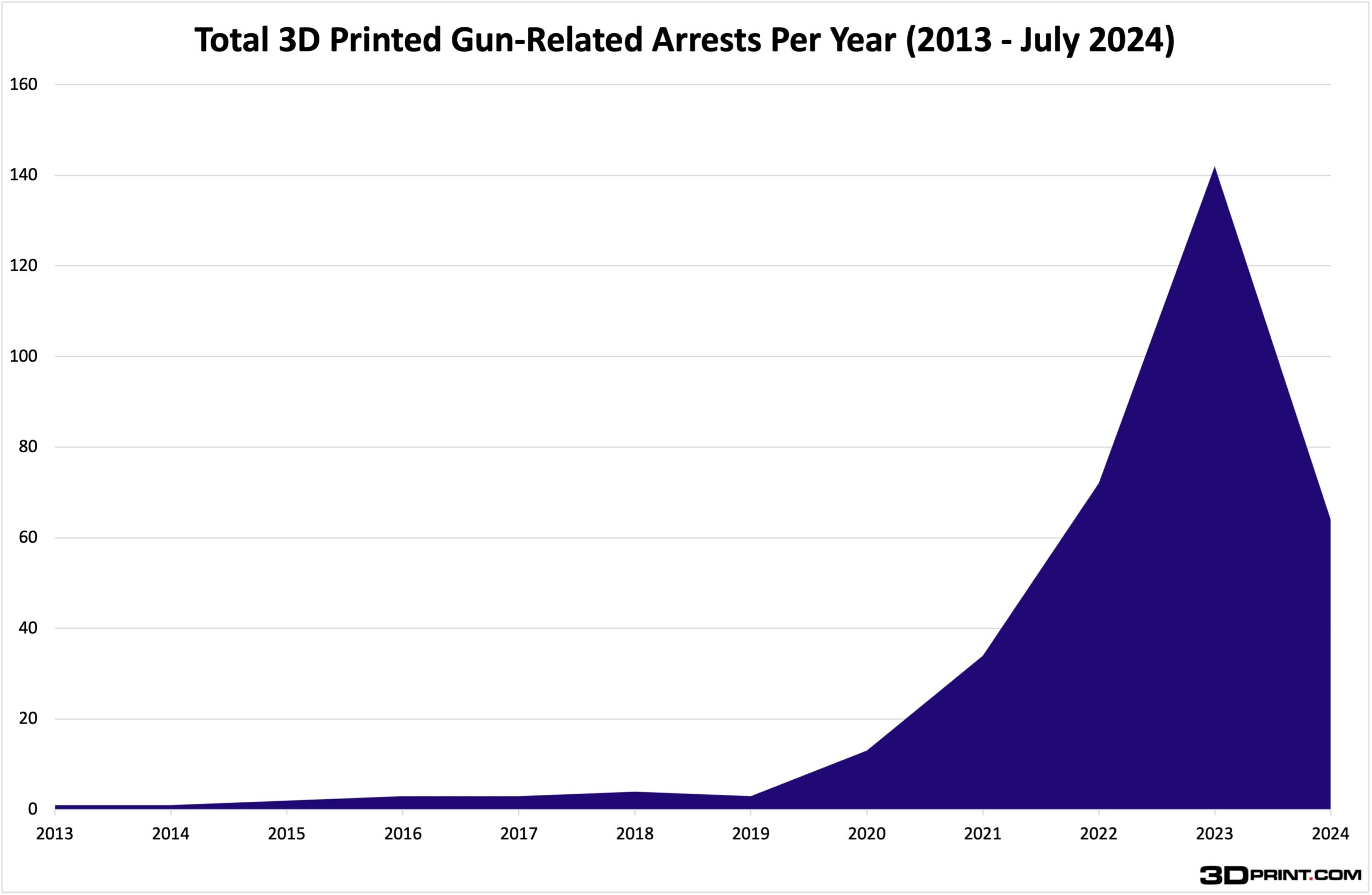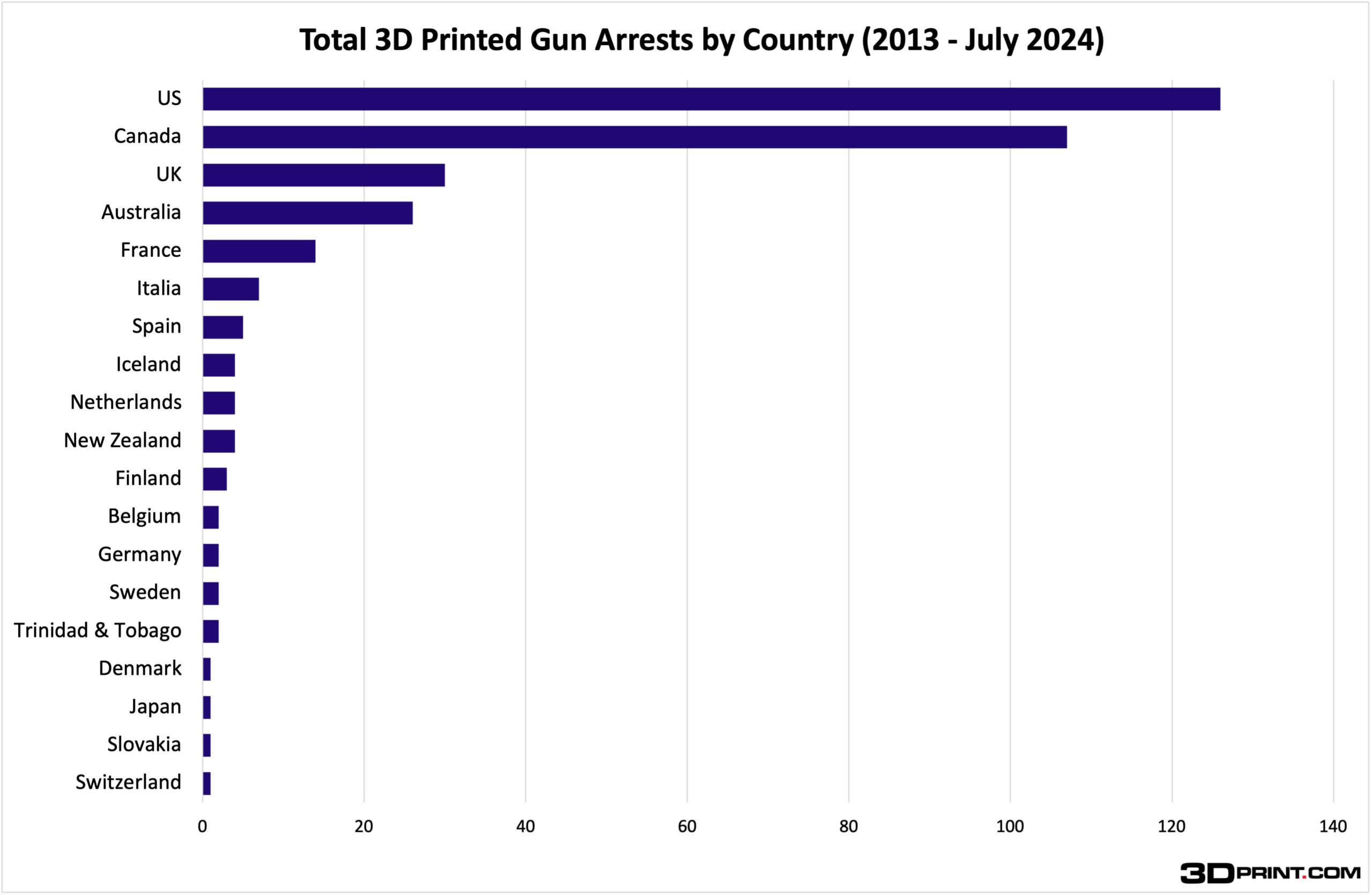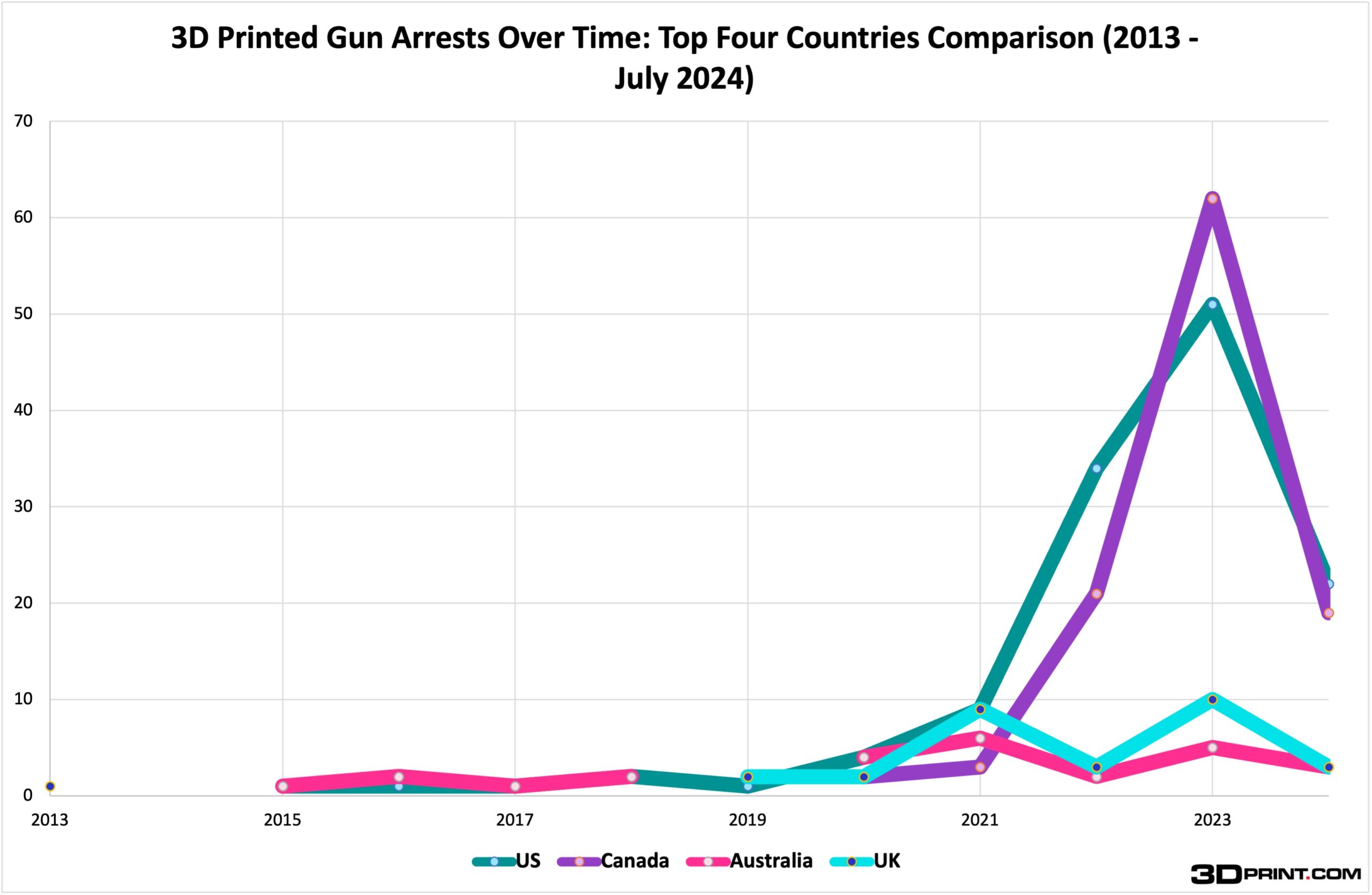3DPrint.com Investigates: 3D Printed Gun Arrests in 2024 Steady, Yet Lower than 2023
Last year, 3DPrint.com reported a significant rise in arrests related to 3D printed guns, and the trend shows no sign of slowing down. By mid-2024, 64 arrests have already been documented worldwide, adding to a decade-long increase that now totals 342 arrests since 2013. This marks a substantial increase from previous years, with 2023 seeing a record 142 arrests.
According to data collected by 3DPrint.com, the trend over the past decade shows a steady increase in arrests. While in 2013, there was only one recorded arrest related to 3D printed firearms, by 2023, this number had risen to 142. Even in the first half of 2024, the number of arrests (64) suggests that the year’s total could surpass many previous years, though it may fall short of 2023’s peak.
Interestingly, in 2023, we reported a record 108 arrests by July, but the total for the year was 142, indicating only 34 arrests in the second half of the year. This decrease raises questions about the possible reasons for the drop in arrests during the latter half of 2023, which could be due to various factors such as increased awareness, changes in enforcement strategies, or shifts in criminal activities.
The first half of 2024 saw 64 arrests, just over half of the 108 arrests recorded in the first half of 2023. This significant decrease might suggest that measures taken in the latter half of 2023 have had a lasting impact, potentially discouraging the production and use of 3D printed firearms. However, it is still too early to determine if this represents a long-term trend. More data from the second half of 2024 and beyond will be needed to draw decisive conclusions.
While it’s important to note that countries don’t always share complete data on all criminals being arrested, and some arrests may go under the radar due to differences in reporting standards or privacy laws, this developing situation will need close watching and further study in the coming months and years.
Country-Specific Insights
Examining the data more closely, we see contrasts in the number of arrests across different countries. The U.S., in particular, remains a hotspot for 3D printed gun-related arrests. In our 2023 report, we noted that the U.S. had arrested a total of 86 people related to 3D printed firearms since 2013. By mid-2024, this number rose to 126, indicating that 40 additional arrests were made just within a year. This sharp increase could indicate law enforcement’s ongoing efforts to combat this issue. What’s more, in July 2024, the 126 arrests in the U.S. account for roughly 37.5% of the total 342 arrests recorded worldwide since 2013.
Canada is now closing in on the U.S. in terms of the number of arrests, indicating a significant rise in 3D-printed gun-related activities. The country saw one of the most dramatic increases, going from an all-time total of 82 arrests from 2013 to 2023 to 107 arrests by mid-2024. This represents a 30.5% increase in arrests in just a year and about 32% of the global total for 2024.
A noteworthy case in June 2024 showcases the crackdown on 3D printed firearms in Canada after police arrested 13 people in Quebec for trafficking and printing 3D guns. This marks the first time suspects in Quebec have been arrested in connection with a pan-Canadian operation targeting 3D printed weapons. According to the Sûreté du Québec (SQ), police forces across Canada have seized 440 illegal homemade guns since the operation began a year ago. Led by the RCMP, officers seized plenty of 3D printers, homemade firearms, and computer data for manufacturing firearms.
In Australia, the total number of arrests related to 3D printed firearms grew from 19 arrests between 2013 and 2023 to 26 by mid-2024. This represents about 8% of the total arrests reported and indicates a 36.8% increase in just one year.
In Europe, the United Kingdom also saw an increase in total arrests. In 2023, we reported an all-time total of 24 arrests, but by mid-2024, that number grew to 30, representing a 25% increase in arrests in just a year and accounting for approximately 9% of the total arrests we have registered. Meanwhile, France went from no arrests in our 2023 data report to 14 in 2024 alone, that was due to a police bust in Marseille to dismantle an arms trafficking network, spanning from the Mediterranean to Belgium, accused of selling 3D printed guns. Officers arrested 14 people and recovered eight 3D printers, seven complete 3D weapons, and 24 conventional weapons. Prosecutors say the trade in such weapons, which can be virtually impossible to trace, is cause for alarm.
Other countries, such as Belgium, Trinidad & Tobago, and Switzerland, also recorded their first arrests related to 3D printed guns in 2024. In Belgium, police dismantled an illegal weapons workshop where ready-to-use weapons were made with a 3D printer to be offered for sale on the dark web. In Switzerland, a person was arrested for the first time for making weapons using a 3D printer, even though it’s illegal to produce pistols, knives, or brass knuckles with a 3D printer in the country.
Finland went one step further and convicted three neo-Nazis in a “race war” terror plot using 3D printed guns in late 2023. Prosecutors showed in court how the men planned to use 3D semi-automatic printed guns to launch the attacks on ethnic and religious minorities, key infrastructure, and political opponents.
Global Distribution and Regulatory Impact
The distribution of arrests highlights a persistent issue in North America and notable rises in other regions. The U.S. and Canada together account for over two-thirds of the total arrests, underscoring the significant impact in these areas. Countries with stringent regulations, like the U.K. and Australia, also show increased arrests, potentially suggesting effective enforcement.
If anything, this consistent rise in arrests indicates growing interest within the black market for 3D printed firearms. These weapons, often untraceable and undetectable, appeal to those seeking to evade authorities. Law enforcement agencies suggest that this trend requires updated and strong regulatory frameworks. However, countries worldwide face the challenge of balancing technological freedom with effective regulation.
All charts courtesy of 3DPrint.com
Subscribe to Our Email Newsletter
Stay up-to-date on all the latest news from the 3D printing industry and receive information and offers from third party vendors.
You May Also Like
Prusa Launches its First High-temp 3D Printer, the Pro HT90
Prusa Research essentially dominates the desktop 3D printing space. Their i3 design is the predominant 3D printer design worldwide, with millions of 3D printers being made each year based on...
3D Printing Success in 3D Printed Minis
An unsung 3D printing success is in 3D printing minis, or miniatures. For over a decade and a half, tabletop gamers, players, and creators have been making 3D printed minis....
Unveiling Dyze Design’s Zephyr High Flow Extruder: Revolutionizing High-Speed 3D Printing
Dyze Design, the Canadian expert in high-performance extrusion systems, introduces its latest innovation, the Zephyr™ High Flow Extruder for 1.75mm filament. This state-of-the-art extruder leverages Dyze Design’s MeltCore™ technology, delivering...
Slant 3D’s API Opens Democratizes 3D Printer Farms
Slant 3D, known for its 3D print farms comprising cost-effective material extrusion machines, has been a subject of our discussions since our interview with founder Gabe Bentz and an article...



































